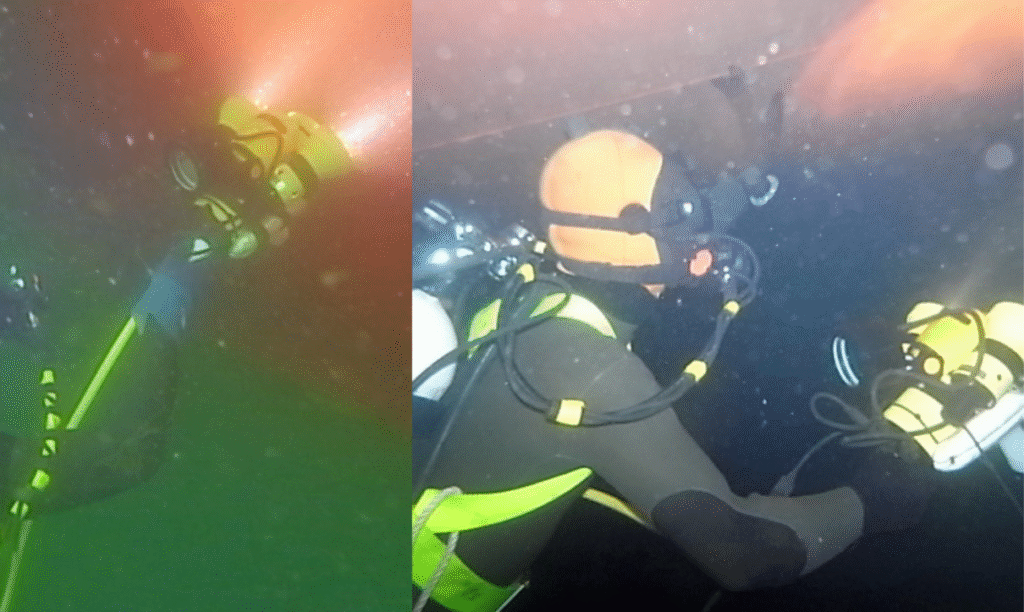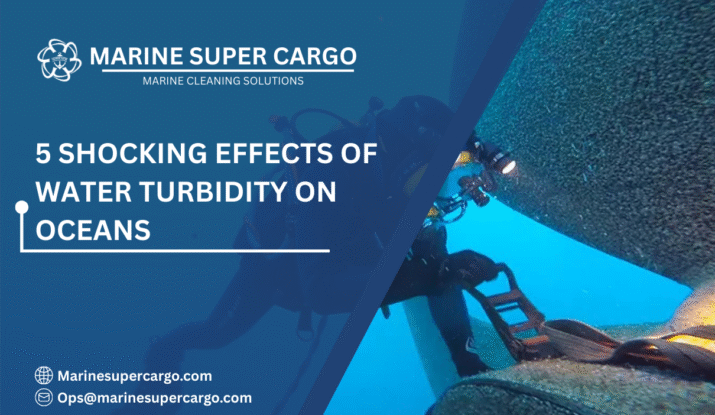Water turbidity is more than just the cloudy appearance of water—it’s a hidden challenge with far-reaching impacts on ecosystems, shipping operations, and global trade. High turbidity affects aquatic life by reducing sunlight penetration, disrupting photosynthesis, and altering habitats.
For ship owners and operators, murky water can complicate underwater inspections, hull cleaning, and maintenance activities, while also increasing environmental compliance risks. Sediment, pollutants, and biofouling organisms carried by turbid water can spread to new areas, raising biosecurity concerns.
Understanding the causes of turbidity—ranging from runoff and dredging to natural sediment movement—helps managers implement effective mitigation strategies. By monitoring and controlling water turbidity, you not only protect marine environments but also enhance operational efficiency, compliance, and cost-effectiveness.
What is Water Turbidity?
Water turbidity refers to the cloudiness or haziness of water caused by suspended particles, such as silt, plankton, algae, or industrial pollutants. Think of it as trying to peer through foggy glasses—the particles scatter light, reducing visibility in the water.
- Why it matters: High turbidity affects aquatic life, reduces sunlight penetration, and can interfere with port operations and hull cleaning.
- Measurement: Scientists use nephelometric turbidity units (NTU) to quantify turbidity.
Water turbidity isn’t always bad—it’s natural in rivers after heavy rains—but excessive turbidity from human activities can have serious environmental consequences.

Causes of Water Turbidity
Understanding the root causes of water turbidity helps in developing effective strategies to reduce its impact.
- Natural Causes:
- River sediment runoff after storms.
- Seasonal algal blooms.
- Tidal and wave action stir up sediments.
- Anthropogenic Causes:
- Dredging operations in ports.
- Industrial effluents and wastewater discharge.
- Coastal construction and land reclamation.
- Ship hull cleaning without proper containment can resuspend fouling organisms and sediments, increasing turbidity. (Reference: CleanShip.co)
✅ 4 Things to Check for Safety at Sea pic.twitter.com/dAxhJQ2i6U
— Marine Super Cargo (@Marinsupercargo) September 14, 2025
Environmental Impacts of Water Turbidity
High water turbidity has cascading effects on the marine environment:
1. Reduced Light Penetration
Sunlight is essential for photosynthesis in aquatic plants. Turbid water reduces light penetration, limiting oxygen production and impacting fish and invertebrates.
2. Altered Food Chains
Suspended particles can clog the gills of fish, reduce zooplankton populations, and affect the entire food chain. For instance, juvenile fish may struggle to find food in murky water.
3. Sediment Smothering
Excess sediment can settle on coral reefs, seagrass beds, and benthic habitats, smothering vital ecosystems.
4. Spread of Pollutants
Suspended particles often bind with heavy metals, chemicals, or microplastics, transporting them across ecosystems and posing long-term risks to marine life.
5. Impacts on Water Quality Compliance
High turbidity can affect water quality metrics required under international regulations, such as MARPOL and IMO guidelines. Non-compliance can lead to fines and operational restrictions.
Effects on Shipping and Port Operations
Water turbidity doesn’t just affect ecosystems; it directly impacts shipping operations:
- Navigation Risks: Reduced underwater visibility increases collision risks and makes port maneuvering challenging.
- Hull Fouling: Murky waters promote biofouling and sediment accumulation, which reduce ship efficiency and increase fuel consumption.
- Dredging Challenges: Ports often have to dredge more frequently to maintain navigable depths, increasing operational costs.
- Regulatory Compliance: Ports and ships must follow environmental standards set by the International Association of Ports & Harbors (IAPH) to minimize turbidity and sediment release.
Water Turbidity and Hull Cleaning
Hull cleaning in turbid waters comes with unique challenges:
- Resuspension of Sediments: Cleaning in murky water can stir up sediments and increase turbidity, causing environmental harm.
- Regulatory Considerations: Using zero-discharge cleaning systems can prevent sediment and invasive species spread (CleanShip.co).
- Efficiency: Poor visibility can make cleaning less precise, increasing paint damage risk and maintenance costs.
Monitoring and Measuring Water Turbidity
Accurate turbidity measurement is critical for environmental management and compliance.
- In-situ Sensors: NTU sensors placed in water provide continuous monitoring.
- Remote Sensing: Satellites can estimate turbidity over large areas.
- Laboratory Tests: Water samples were analyzed in labs for suspended solids.
Monitoring turbidity helps port authorities, ship operators, and environmental agencies identify problem areas and implement solutions promptly.
Reducing Water Turbidity: Best Practices
1. Containment During Hull Cleaning
- Use filtration and sediment capture systems to prevent resuspension of fouling and sediments.
- Deploy zero-discharge technologies to maintain compliance with MARPOL regulations.
2. Sustainable Dredging Practices
- Schedule dredging during periods of low ecological sensitivity.
- Use silt curtains or turbidity screens to minimize sediment dispersion.
3. Coastal Management
- Stabilize shorelines to reduce erosion.
- Implement vegetation buffers along rivers and coastlines.
4. Pollution Control
- Treat industrial wastewater before discharge.
- Monitor and regulate ship ballast water and effluents.
5. Technology Innovations
- AI-driven sensors to track turbidity in real-time.
- Autonomous underwater robots for efficient hull cleaning without increasing turbidity (IMCA-Int).
Future Trends in Water Turbidity Management
- Smart Ports: Real-time turbidity monitoring integrated with operational dashboards.
- Advanced Coatings: Nanotech hull coatings reduce biofouling and lower cleaning frequency.
- Eco-friendly Cleaning Systems: Zero-discharge hydraulic and pneumatic tools that minimize environmental impact.
- Global Regulatory Alignment: Harmonization of turbidity standards under IMO and regional authorities ensures consistent environmental protection.

Economic and Operational Benefits of Managing Turbidity
- Fuel Savings: Reduced hull fouling lowers drag, saving fuel.
- Reduced Maintenance Costs: Less frequent cleaning prevents paint damage and prolongs hull life.
- Regulatory Compliance: Avoid fines and port restrictions.
- Enhanced Reputation: Environmentally responsible operations strengthen stakeholder trust.
Conclusion
Water turbidity is more than just cloudy water—it’s a vital environmental and operational metric. By understanding its causes, impacts, and solutions, we can protect marine ecosystems, optimize ship operations, and ensure compliance with international standards. Three key takeaways:
- Excessive turbidity disrupts ecosystems and reduces underwater visibility.
- Proper monitoring and sustainable practices minimize environmental and operational risks.
- Zero-discharge hull cleaning systems and technological innovations can save costs while protecting the environment.
Protect your vessel and the ocean by partnering with experts like CleanShip.co for sustainable, compliant solutions.
FAQs:
Q1. What is considered high water turbidity?
High turbidity is usually above 5 NTU in freshwater and above 25 NTU in marine environments, depending on local regulations and environmental conditions.
Q2. How does water turbidity affect marine life?
Excessive turbidity reduces sunlight penetration, hampers photosynthesis, smothers habitats, and can clog fish gills, impacting growth and survival.
Q3. Can turbidity impact ship operations?
Yes. Murky waters can reduce visibility, promote hull fouling, increase fuel consumption, and complicate port navigation.
Q4. What technologies help manage water turbidity?
In-situ sensors, AI monitoring systems, satellite remote sensing, and autonomous hull cleaning robots are effective tools to track and reduce turbidity.
Q5. How can ship operators stay compliant with turbidity regulations?
Using zero-discharge hull cleaning systems, monitoring NTU levels, and following MARPOL and IMO guidelines help maintain environmental compliance and avoid fines.


